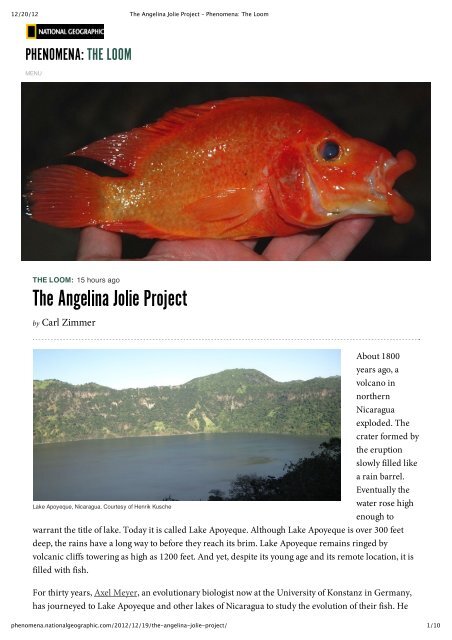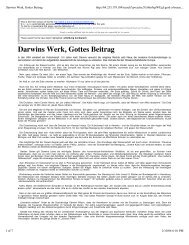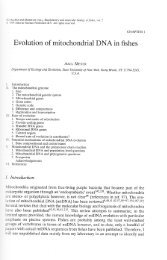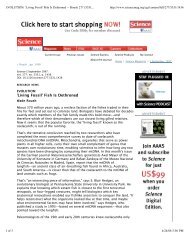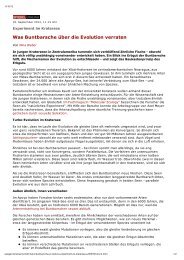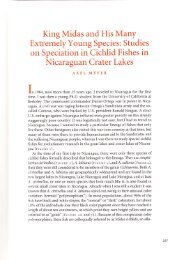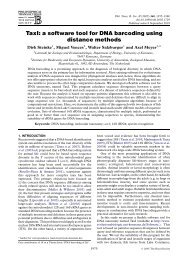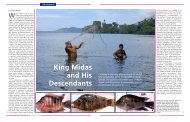by Carl Zimmer - Evolutionsbiologie at the University of Konstanz
by Carl Zimmer - Evolutionsbiologie at the University of Konstanz
by Carl Zimmer - Evolutionsbiologie at the University of Konstanz
You also want an ePaper? Increase the reach of your titles
YUMPU automatically turns print PDFs into web optimized ePapers that Google loves.
12/20/12 The Angelina Jolie Project – Phenomena: The Loom<br />
THE LOOM<br />
PHENOMENA:<br />
MENU<br />
THE LOOM: 15 hours ago<br />
Angelina Jolie Project<br />
The<br />
<strong>by</strong> <strong>Carl</strong> <strong>Zimmer</strong><br />
Lake Apoyeque, Nicaragua. Courtesy <strong>of</strong> Henrik Kusche<br />
phenomena.n<strong>at</strong>ionalgeographic.com/2012/12/19/<strong>the</strong>-angelina-jolie-project/<br />
About 1800<br />
years ago, a<br />
volcano in<br />
nor<strong>the</strong>rn<br />
Nicaragua<br />
exploded. The<br />
cr<strong>at</strong>er formed <strong>by</strong><br />
<strong>the</strong> eruption<br />
slowly filled like<br />
a rain barrel.<br />
Eventually <strong>the</strong><br />
w<strong>at</strong>er rose high<br />
enough to<br />
warrant <strong>the</strong> title <strong>of</strong> lake. Today it is called Lake Apoyeque. Although Lake Apoyeque is over 300 feet<br />
deep, <strong>the</strong> rains have a long way to before <strong>the</strong>y reach its brim. Lake Apoyeque remains ringed <strong>by</strong><br />
volcanic cliffs towering as high as 1200 feet. And yet, despite its young age and its remote loc<strong>at</strong>ion, it is<br />
filled with fish.<br />
For thirty years, Axel Meyer, an evolutionary biologist now <strong>at</strong> <strong>the</strong> <strong>University</strong> <strong>of</strong> <strong>Konstanz</strong> in Germany,<br />
has journeyed to Lake Apoyeque and o<strong>the</strong>r lakes <strong>of</strong> Nicaragua to study <strong>the</strong> evolution <strong>of</strong> <strong>the</strong>ir fish. He<br />
1/10
12/20/12 The Angelina Jolie Project – Phenomena: The Loom<br />
and his colleagues have caught cichlids and sequenced <strong>the</strong>ir DNA. By comparing <strong>the</strong>ir genes, <strong>the</strong><br />
scientists can work out how <strong>the</strong> fish spread across <strong>the</strong> country. At Lake Apoyeque, for example, <strong>the</strong>y<br />
found th<strong>at</strong> <strong>the</strong> cichlids shared a number <strong>of</strong> mut<strong>at</strong>ions with <strong>the</strong> cichlids <strong>of</strong> Lake Managua near<strong>by</strong>. The<br />
fish <strong>of</strong> Lake Apoyeque have accumul<strong>at</strong>ed rel<strong>at</strong>ively few mut<strong>at</strong>ions <strong>of</strong> <strong>the</strong>ir own. Meyer and his<br />
colleagues studied those mut<strong>at</strong>ions to estim<strong>at</strong>e how long it took for <strong>the</strong>ir genetic diversity to evolve.<br />
They concluded th<strong>at</strong> <strong>the</strong> cichlids came from Lake Managua to Lake Apoyeque only about a century<br />
ago.<br />
There are forests and cliffs dividing Lake Managua and Lake Apoyeque, and no one can say exactly<br />
how <strong>the</strong> fish leaped over <strong>the</strong>m around 1900. One likely route is a w<strong>at</strong>er spout. W<strong>at</strong>er spouts are known<br />
to pass over Nicaragua, and it’s possible th<strong>at</strong> every few thousand years one <strong>of</strong> <strong>the</strong>m happens to suck up<br />
fish from one lake along <strong>the</strong> way and drops <strong>the</strong>m in ano<strong>the</strong>r.<br />
But this aerial journey is not <strong>the</strong> most remarkable thing about <strong>the</strong> fish <strong>of</strong> Lake Apoyeque. Wh<strong>at</strong> is most<br />
remarkable is obvious if you pick <strong>the</strong>m up and take a close look <strong>at</strong> <strong>the</strong>m.<br />
It’s <strong>the</strong>ir lips.<br />
Thin- and thick-lipped cichlids from Lake Apoyeque. From Elmer et al BMC Biology 2010<br />
phenomena.n<strong>at</strong>ionalgeographic.com/2012/12/19/<strong>the</strong>-angelina-jolie-project/<br />
Most <strong>of</strong> <strong>the</strong><br />
cichlids in Lake<br />
Apoyeque, like<br />
<strong>the</strong> one on <strong>the</strong><br />
top, have thin,<br />
pursed lips. But<br />
some have<br />
plump, full lips,<br />
with <strong>the</strong> sort <strong>of</strong><br />
curves th<strong>at</strong><br />
Upper East Side<br />
plastic surgeons<br />
charge dearly to<br />
provide to<br />
human beings.<br />
You can find <strong>the</strong><br />
same two types<br />
<strong>of</strong> fish mouths<br />
in Lake<br />
Managua. In lake after lake in Nicaragua, you can find more thin-lipped cichlids living alongside thick-<br />
lipped ones. You can find <strong>the</strong>m thousands <strong>of</strong> miles away, on <strong>the</strong> cichlids in African lakes. In many<br />
cases, cichlids th<strong>at</strong> have colonized a new lake have rapidly evolved into two distinct popul<strong>at</strong>ions: one<br />
with big lips, and one without.<br />
Meyer and his colleagues study <strong>the</strong> cichlids <strong>of</strong> Africa and Central America to explore many <strong>of</strong> <strong>the</strong> most<br />
pr<strong>of</strong>ound questions about how life evolves. They investig<strong>at</strong>e how <strong>the</strong>se fishes are diverging into new<br />
species, how <strong>the</strong>y are evolving preferences about <strong>the</strong>ir choice <strong>of</strong> a m<strong>at</strong>e, how <strong>the</strong>y are evolving different<br />
2/10
12/20/12 The Angelina Jolie Project – Phenomena: The Loom<br />
A thick-lipped cichlid from Lake Tanganyika in Africa. Photo <strong>by</strong> Ad Konings<br />
found in o<strong>the</strong>r isol<strong>at</strong>ed lakes.<br />
To understand this parallel evolution, Meyer and his colleagues are<br />
taking a close look <strong>at</strong> those lips, investig<strong>at</strong>ing how <strong>the</strong> cichlids use <strong>the</strong>m<br />
and how <strong>the</strong>ir genes produce <strong>the</strong>m. In <strong>the</strong>ir lab back in Germany, <strong>the</strong><br />
scientists like to call it “<strong>the</strong> Angelina Jolie project.”<br />
If you w<strong>at</strong>ch thick-lipped cichlids in action, you can see how n<strong>at</strong>ural<br />
selection could favor <strong>the</strong> mut<strong>at</strong>ions th<strong>at</strong> plumped up <strong>the</strong>ir mouths.<br />
They typically push <strong>the</strong>ir mouths into crevices <strong>of</strong> rocks on <strong>the</strong> bottoms<br />
<strong>of</strong> lakes. They <strong>the</strong>n use <strong>the</strong>ir ample lips to form a seal around <strong>the</strong>ir<br />
prey–<strong>the</strong>y <strong>of</strong>ten choose crabs or o<strong>the</strong>r animals lurking in <strong>the</strong> crevices–<br />
which <strong>the</strong>y <strong>the</strong>n suck into <strong>the</strong>ir mouths. The volcanic rocks are sharp-<br />
edged, and <strong>the</strong> cichlid’s padded lips provide <strong>the</strong>m with protection.<br />
phenomena.n<strong>at</strong>ionalgeographic.com/2012/12/19/<strong>the</strong>-angelina-jolie-project/<br />
ways <strong>of</strong> making<br />
a living. One <strong>of</strong><br />
<strong>the</strong> most<br />
interesting<br />
things about<br />
cichlids is th<strong>at</strong><br />
once <strong>the</strong>y<br />
become isol<strong>at</strong>ed<br />
in lakes, <strong>the</strong>y<br />
end up evolving<br />
many <strong>of</strong> <strong>the</strong><br />
same traits<br />
Photo <strong>by</strong> Stefan<br />
Servos/Wikipedia/Cre<strong>at</strong>ive Commons<br />
Thin-lipped cichlids, on <strong>the</strong> o<strong>the</strong>r hand, search for o<strong>the</strong>r kinds <strong>of</strong> food in <strong>the</strong> open w<strong>at</strong>er, where <strong>the</strong>y<br />
don’t need to vaccum up <strong>the</strong>ir prey.<br />
These are both perfectly suitable ways <strong>of</strong> making a living in a volcanic lake. But cichlids th<strong>at</strong> are better<br />
adapted to one way or <strong>the</strong> o<strong>the</strong>r may have better luck than a cichlid-<strong>of</strong>-all-trades. N<strong>at</strong>ural selection will<br />
<strong>the</strong>n favor cichlids <strong>at</strong> <strong>the</strong> two an<strong>at</strong>omical extremes instead <strong>of</strong> those in <strong>the</strong> middle.<br />
Until recently, it was impossible to probe <strong>the</strong> genes <strong>of</strong> <strong>the</strong> cichlids to see wh<strong>at</strong> mut<strong>at</strong>ions n<strong>at</strong>ural<br />
selection was acting on. Scientists like Meyer didn’t know wh<strong>at</strong> to look for. But in recent years a large<br />
consortium <strong>of</strong> scientists (including Meyer) have sequenced <strong>the</strong> genomes <strong>of</strong> cichlids. Now <strong>the</strong>y have a<br />
map to guide <strong>the</strong>m as <strong>the</strong> zoom in on <strong>the</strong> molecular details <strong>of</strong> cichlid evolution.<br />
To investig<strong>at</strong>e cichlid lips, Meyer and his colleagues caught cichlids from four lakes. Two <strong>of</strong> <strong>the</strong> lakes<br />
were young (Apoyeque, 1800 years old; Mayasa, 6000 years old), while <strong>the</strong> o<strong>the</strong>r two were big, old lakes<br />
from which <strong>the</strong> young lake cichlids traveled. (Lake Managua and Lake Nicaragua are both about<br />
500,000 years old.)<br />
As you can see from this figure from <strong>the</strong>ir new paper, all four lakes have <strong>the</strong>ir own pairs <strong>of</strong> thin- and<br />
thick-lipped cichlids. (Click on <strong>the</strong> image to enlarge)<br />
3/10
12/20/12 The Angelina Jolie Project – Phenomena: The Loom<br />
From Manousaki et al, Molecular Ecology 2012<br />
Meyer and his colleagues clipped <strong>of</strong>f a sample from <strong>the</strong> lip <strong>of</strong> each <strong>of</strong> <strong>the</strong>ir cichlids. They <strong>the</strong>n looked<br />
for signs <strong>of</strong> active genes in <strong>the</strong> lip cells. They wanted to see if thick-lipped cichlids made a bigger (or<br />
smaller) supply <strong>of</strong> certain proteins than thin-lipped ones. Changing <strong>the</strong> levels <strong>of</strong> proteins has long been<br />
known to be a powerful engine for evolutionary change.<br />
The scientists found many such genes. In Lake Apoyeque, for example, 149 genes had significantly<br />
different levels <strong>of</strong> activity in <strong>the</strong> thin- and thick-lipped cichlids. In Lake Managua, <strong>the</strong>re were 512 genes<br />
th<strong>at</strong> were different.<br />
Across all four lakes, however, six genes consistently behaved differently in <strong>the</strong> two kinds <strong>of</strong> cichlids.<br />
Meyer argues th<strong>at</strong> <strong>the</strong>se genes are crucial for evolving big lips. Some <strong>of</strong> <strong>the</strong>m are known to control <strong>the</strong><br />
growth <strong>of</strong> cartilage and muscle. Changing <strong>the</strong> levels <strong>of</strong> <strong>the</strong> proteins made <strong>by</strong> <strong>the</strong>se genes might allow<br />
cichlids to bulk up <strong>the</strong>ir lips. Some <strong>of</strong> <strong>the</strong> o<strong>the</strong>r genes Meyer and his researchers identified help build<br />
<strong>the</strong> nervous system. This discovery raises <strong>the</strong> intriguing possibility th<strong>at</strong> <strong>the</strong> thick-lipped cichlids use<br />
<strong>the</strong>ir lips not just to form a seal over <strong>the</strong>ir prey. Their lips may be studded with odor-sensing receptors<br />
th<strong>at</strong> help <strong>the</strong>m sniff out <strong>the</strong>ir prey.<br />
Meyer’s new study suggests th<strong>at</strong> evolution repe<strong>at</strong>s itself, up to a point. In four different lakes, it appears<br />
th<strong>at</strong> <strong>the</strong> same kinds <strong>of</strong> adapt<strong>at</strong>ions have evolved in cichlids through changes to <strong>the</strong> same six genes. If<br />
you want thick lips, <strong>the</strong>re are not an infinite number <strong>of</strong> ways to get <strong>the</strong>m. Meyer and his colleagues have<br />
also found th<strong>at</strong> thick-lipped cichlids also evolve o<strong>the</strong>r traits in all four lakes. As you can see in <strong>the</strong><br />
figure above, <strong>the</strong>ir heads have a conical shape, whereas thin-lipped cichlids have a blunter face. All<br />
those parallel traits may be part <strong>of</strong> <strong>the</strong> same suction-feeding package. To feed among rocks, it helps not<br />
just to have luscious lips, but also to have a narrow head you can push into crevices.<br />
Carmelo Fruciano, Gonzalo Machado Schiaffino, and Axel<br />
Meyer check out cichlids for sale <strong>at</strong> a market in Granada, on<br />
phenomena.n<strong>at</strong>ionalgeographic.com/2012/12/19/<strong>the</strong>-angelina-jolie-project/<br />
At <strong>the</strong> same time, however, evolution is playing out<br />
differently in <strong>the</strong> lakes. Most <strong>of</strong> <strong>the</strong> genes with different<br />
activities in Lake Apoyeque are not <strong>the</strong> same as <strong>the</strong> ones<br />
in Lake Nicaragua, for example. There are differences in<br />
an<strong>at</strong>omy, too. Thick-lipped fishes in <strong>the</strong> some lakes have<br />
narrow teeth, while thick-lipped fish in o<strong>the</strong>r lakes have<br />
broader ones.<br />
There are several possible explan<strong>at</strong>ions for <strong>the</strong>se<br />
differences. The lakes are not identical, for one thing.<br />
4/10
12/20/12 The Angelina Jolie Project – Phenomena: The Loom<br />
<strong>the</strong> banks <strong>of</strong> Lake Nicaragua<br />
Like 135 43 42<br />
phenomena.n<strong>at</strong>ionalgeographic.com/2012/12/19/<strong>the</strong>-angelina-jolie-project/<br />
Some lakes have a bigger variety <strong>of</strong> habit<strong>at</strong>s for cichlids to<br />
adapt to; one lake may have a different collection <strong>of</strong> animals for <strong>the</strong> fish to hunt. And some <strong>of</strong> <strong>the</strong><br />
differences Meyer and his colleagues have found may be little more than <strong>the</strong> result <strong>of</strong> a genetic roll <strong>of</strong><br />
<strong>the</strong> dice. When a w<strong>at</strong>er spout picked up a few cichlids in Lake Managua, <strong>the</strong>y may have had some<br />
peculiar mut<strong>at</strong>ions th<strong>at</strong> were unusual in <strong>the</strong> popul<strong>at</strong>ion as a whole. But when <strong>the</strong>y fell into Lake<br />
Apoyeque, those peculiar fish now became <strong>the</strong> entire popul<strong>at</strong>ion <strong>of</strong> cichlids in <strong>the</strong>ir new home.<br />
O<strong>the</strong>r scientists have also found a mix <strong>of</strong> similarities and differences in parallel evolution. They’re<br />
finding this complex p<strong>at</strong>tern in <strong>the</strong> legs <strong>of</strong> lizards on Carribean islands, in bacteria adapting to a<br />
starv<strong>at</strong>ion diet, and echoloc<strong>at</strong>ion in b<strong>at</strong>s and whales. The thick lips <strong>of</strong> Lake Apoyeque are not an odd<br />
reflection <strong>of</strong> a Hollywood star, it turns out. They are a clue to one <strong>of</strong> <strong>the</strong> most important p<strong>at</strong>terns in <strong>the</strong><br />
history <strong>of</strong> life.<br />
[Unless o<strong>the</strong>rwise noted, all images are courtesy <strong>of</strong> Axel Meyer. Jolie on Wikipedia]<br />
are 5 Comments. Add Yours.<br />
There<br />
Russ Abbott<br />
December 19, 2012<br />
So <strong>the</strong> moral is: w<strong>at</strong>ch out when you kiss Angelina Jolie?<br />
kylee<br />
December 19, 2012<br />
Wow. All <strong>the</strong>se ideas do add up and seem very possible. I enjoyed how you researched all this inform<strong>at</strong>ion out to come<br />
up with ideas. Hope you succeed in your final analysis.<br />
Aloysius Horn<br />
December 19, 2012<br />
My guess is th<strong>at</strong> <strong>the</strong> thick-lipped variety morphotype is correl<strong>at</strong>ed with higher expression <strong>of</strong> lipoproteins.<br />
220mya<br />
December 19, 2012<br />
Why aren’t humans or birds considered likely dispersal mechanisms for <strong>the</strong> Lake Apoyeque cichlids?<br />
winda<br />
December 19, 2012<br />
<strong>the</strong> lips <strong>of</strong> fishes like angelina jolie, or <strong>the</strong> lip <strong>of</strong> angelina jolie like <strong>the</strong> fishes??<br />
Your Comments<br />
Add<br />
All fields required.<br />
YOUR NAME<br />
5/10
12/20/12 The Angelina Jolie Project – Phenomena: The Loom<br />
YOUR EMAIL<br />
YOUR COMMENTS<br />
SUBMIT<br />
NOTIFY ME OF FOLLOW-UP COMMENTS BY EMAIL.<br />
NOTIFY ME OF NEW POSTS BY EMAIL.<br />
RELATED POSTS<br />
THE LOOM: 2 days ago<br />
When You Swallow A Grenade<br />
In 1941, a rose killed a policeman. Albert Alexander, a 43-year-old policeman in Oxford, England, ...<br />
phenomena.n<strong>at</strong>ionalgeographic.com/2012/12/19/<strong>the</strong>-angelina-jolie-project/<br />
6/10
12/20/12 The Angelina Jolie Project – Phenomena: The Loom<br />
Read more 18<br />
THE LOOM: 2 days ago<br />
Moving Day<br />
Welcome to <strong>the</strong> Loom. I’d like to use my first post here to introduce myself ...<br />
Read more<br />
THE LOOM: 7 days ago<br />
phenomena.n<strong>at</strong>ionalgeographic.com/2012/12/19/<strong>the</strong>-angelina-jolie-project/<br />
7<br />
7/10
12/20/12 The Angelina Jolie Project – Phenomena: The Loom<br />
A Very Special Tree <strong>of</strong> Life<br />
Yesterday I went to Rutgers <strong>University</strong> to give a talk about medical ecology. Afterwards, I got ...<br />
Read more<br />
THE LOOM: 9 days ago<br />
The Loom Weaves Onward<br />
I’ve got some blog news. Starting next week, I will be publishing <strong>the</strong> Loom with N<strong>at</strong>ional ...<br />
Read more<br />
THE LOOM: 10 days ago<br />
#Reddit Now (AMAA)<br />
On<br />
Let’s talk!<br />
Read more<br />
THE LOOM: 10 days ago<br />
Turning Fins Into Hands<br />
Your hands are, roughly speaking, 360 million years old. Before <strong>the</strong>n, <strong>the</strong>y were fins, which ...<br />
Read more<br />
phenomena.n<strong>at</strong>ionalgeographic.com/2012/12/19/<strong>the</strong>-angelina-jolie-project/<br />
MORE RELATED POSTS »<br />
0<br />
0<br />
0<br />
0<br />
8/10
12/20/12 The Angelina Jolie Project – Phenomena: The Loom<br />
ABOUT<br />
<strong>Carl</strong> <strong>Zimmer</strong> is an award-winning science writer whose work appears frequently in <strong>the</strong> New York Times, N<strong>at</strong>ional<br />
Geographic, and o<strong>the</strong>r public<strong>at</strong>ions. He is <strong>the</strong> author <strong>of</strong> 13 books, including Parasite Rex and The Tangled Bank: An<br />
Introduction to Evolution. You can find him on Twitter, Facebook, Pinterest, and Google+.<br />
RECENT POSTS ON THE LOOM<br />
The Angelina Jolie Project<br />
When You Swallow A Grenade<br />
Moving Day<br />
A Very Special Tree <strong>of</strong> Life<br />
The Loom Weaves Onward<br />
SEARCH THIS BLOG<br />
SEARCH FOR:<br />
SEARCH<br />
Twitter<br />
@VinnyBurgoo @edyong209 @Laelaps @virginiahughes @keithkloor Bug <strong>of</strong>f, troll. 9 hours ago<br />
It was a good week for stories <strong>of</strong> artificial languages. @joshuafoer in NYer: newyorker.com/reporting/2012… &<br />
@wnycradiolab radiolab.org/2012/dec/17/ma… 13 hours ago<br />
At @Download<strong>the</strong>Uni @sethmnookin reflect on <strong>the</strong> l<strong>at</strong>est e-book from @readm<strong>at</strong>ter on regener<strong>at</strong>ing organs<br />
download<strong>the</strong>universe.com/dtu/2012/12/be… 13 hours ago<br />
META<br />
Log in<br />
Entries RSS<br />
Comments RSS<br />
WordPress.org<br />
POSTING RULES<br />
phenomena.n<strong>at</strong>ionalgeographic.com/2012/12/19/<strong>the</strong>-angelina-jolie-project/<br />
9/10
12/20/12 The Angelina Jolie Project – Phenomena: The Loom<br />
Opinions expressed in blogs are those <strong>of</strong> <strong>the</strong> blogger and/or <strong>the</strong> blogger's organiz<strong>at</strong>ion, and not necessarily those <strong>of</strong> <strong>the</strong><br />
N<strong>at</strong>ional Geographic Society. Bloggers and commenters are required to observe N<strong>at</strong>ional Geographic's community<br />
rules.<br />
CATEGORIES<br />
Select C<strong>at</strong>egory<br />
phenomena.n<strong>at</strong>ionalgeographic.com/2012/12/19/<strong>the</strong>-angelina-jolie-project/<br />
10/10


